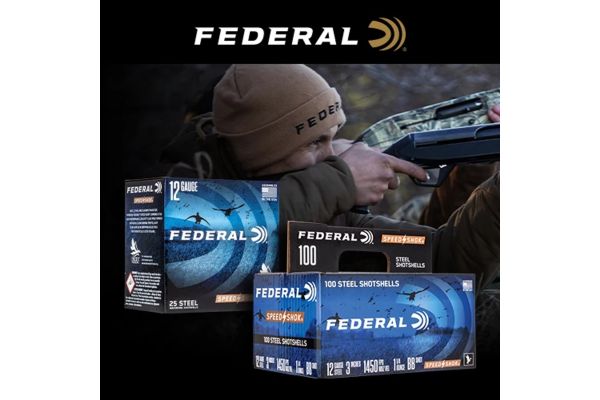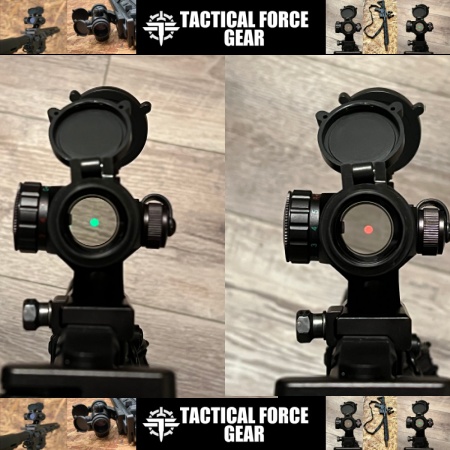We may earn revenue from the products available on this page and participate in affiliate programs. Learn More ›
Over the last several years I’ve become a big proponent of using red dots for turkey hunting. They aid in precise aiming at longer distances and help prevent the shooter from looking over the barrel (instead of down it) at close distances or when shooting from awkward positions. So I was thrilled to see the initial designs of Vortex’s new Viper red dot.
This enclosed emitter is built from a single piece of 6061 aluminum and mounts directly to the receiver of most shotguns — it will also work on carbines and lever guns. Because no rail or adapter is required, the Viper sits extra low on the receiver which allows for a more natural gun mount and a solid cheek weld.
The design looks to solve the core problem with a lot of shotgun red dots, which is that they sit high above the receiver and cause the shooter to lift his head off the stock in order to see through the sight. The other issue that comes with throwing a red dot on your shotgun is that you must find a compatible Picatinny rail and often an adapter that matches the footprint of your optic. If you’re not spun up on red dots styles or mounts and you’re just a workaday turkey killer, the process can be a bit of a pain.
While I love the Viper concept, I was curious to see if it would hold zero under the punishing recoil of heavy turkey loads. Shooting Editor John B. Snow and I got our hands on a few of these dots and range tested them to find out.
See It
- Weight: 2.14 ounces
- Objective Lens Size: .69 inches x .87 inches
- Reticle: 3 MOA, 32 MOA circle, 65 MOA circle
- Adjustment: 12 brightness settings
- Advertised Battery Life: 50,000 (single dot, setting #6)
- Battery: CR 2032
- Includes most common mounting screw sets
- Rubber cover
- Motion activated with 10-minute shut off
- MAP: $300 (single reticle); $350 (multi reticle)
Testing the Vortex Viper Red Dot
Mounting the Red Dot

Before the fun could start, I first had to get a couple Vipers on a pair of shotguns. Vortex says the Viper mounting system is compatible with a wide variety of shotguns, including the most popular turkey guns made by Remington, Mossberg, Benelli, and others. Of course, the shotgun on your receiver must be drilled and tapped. For a full list of shotguns that have been confirmed to be compatible (and the mounting screw type to use with each), click here.
According to the mounting instructions, all you need is one screw in the rear hole and one in the front mounting channel. If the layout of your receiver allows you to install more screws, then do so. I mounted one Viper to a Stoeger M3000 tactical gun and another to a Mossberg 500 turkey gun. In both cases I was able to install three mounting screws. I sincerely appreciated the fact that Vortex included the most common mounting screws (clearly labeled) and directions on which screws to use with each gun.
A Note on Torque
It’s important that each screw is torqued to 12-inch pounds, this is even etched into the mount so you don’t forget. Vortex did a bunch of testing with both steel and aluminum receivers before settling on this number. They also tested the Viper dots through 1,000 rounds of live fire and the additional simulated recoil of 5,000 rounds through a recoil machine to ensure that there was no slipping or electronics failure.
Zeroing and Recoil Testing

I did not have a recoil simulator for testing the Viper, But I did have a bunch of old duck and turkey loads rolling around my truck and a good buddy to help me shoot them.
So after I mounted the Viper red dot to the tactical shotgun, I sighted in at 25 yards with slugs to ensure that my point of aim and point of impact were synched precisely.
Then my hunting buddy Todd Gifford and I started blazing away. We ran through two boxes of target loads to get warmed up and then 50 rounds of 3-inch waterfowl and turkey loads. The Stoeger is an inertia gun (there is no gas system to soften the blow), so the recoil from those magnum loads was nothing short of teeth rattling. We fired in four- and six-round bursts as quickly as we could.
With the barrel still hot, I went back to shooting groups with slugs at 25 yards. To our delight, and great relief, the zero had not shifted at all and slug after slug landed in the bottom of the bullseye just where I had initially zeroed.
I then used my torque wrench to see if the mounting screws were still tight. The rear screw had loosened ever so slightly (my guess is about one inch pound) but the other two were perfect. The sight and mount were still rock steady.
My takeaway was that after you shoot about 50 turkey loads with this red dot, it might be worth re-inspecting the mounting screws, but otherwise you’re good to go. If you were really worried about it, you could apply some extra threadlocker when mounting.
Reticles

There are two Viper variations: one with a single 3 MOA dot and one with a seven reticle options. If you are planning on using the Viper specifically for turkey hunting, I’d recommend saving the $50 and going with the single dot reticle. I’ve found that in most turkey hunting scenarios a simple dot and a clear sight picture are the best for precise shooting.
However, when running basic speed drills with the tactical, gun I liked the multi-reticle option. The bright 65 MOA circle with a dot in the middle was perfect for 10-yard IPSC targets.
While I’m not a fan of using red dots for wingshooting, the multi-reticle options have application here. According to Vortex, the 32 MOA circle roughly matches the pattern of a full choke and the 65-MOA dot roughly matches the pattern of a modified choke.
Mounting on a Turkey Gun
I mounted the other Viper on my Mossberg 500 .410 turkey shotgun. I’ve used a few different red dots on this gun over the years, but none suited it as perfectly as the Viper. The low profile housing makes for a sleek little setup that will be maneuverable and handy in the woods.
I was able to establish a good, firm cheek weld and see through the sight without issue. For comparison, below are photos of my Mossberg 835 complete with a rail and red dot atop an adapter plate. In order to get enough comb height to see through this sight, I duck taped strips of foam to the stock. This is obviously not necessary with the Viper mount.

While shooting with the Viper I practiced toggling the brightness with the buttons on top of the sight. They were responsive and easy to manipulate from a shooting position.
From a sight clarity perspective, the Viper delivers about what you’d expect from a mid-priced red dot. There is a noticeable blue/green tint to the lenses and a bit of a starburst around the dot itself. But these are more quibbles rather than real issues that make a difference when it’s time to shoot a turkey.
I like that the Viper is an enclosed emitter red dot. The design helps keep mud, debris, and moisture out of the optic. For a simple waterproofness test I ran it under my kitchen faucet for about two minutes. With water splotches on both lenses the dot was still crisp enough for me to shoot with.
Mounting on a Lever Gun

Shooting Editor John Snow also received one of the Vortex Vipers to test. He ran it on one of Henry’s new Lever Action Supremes chambered in .223/5.56. Here’s what he had to say:
“I was able to mount the sight quickly using all four of the holes on the carbine’s receiver. The sight’s low profile works extremely well with the Henry’s stock dimensions allowing for fast target acquisition and a proper cheek weld.
“The sight was essentially zeroed from the get go, hitting just a couple inches low at 25 yards. I ran the rifle and optic through a series of drills on steel targets, focusing on rapid transitions. The Henry/Vortex combo was incredibly quick and accurate. It would make a great truck gun for coyotes and a hell of a deer rifle for use in a tree stand or while still-hunting in timber.

“During my range session the temps were in the teens, and I was able to adjust the illumination level of the dot easily while wearing gloves, which is indicative of the sight’s smart ergonomics. While the Viper’s main purpose is for use on shotguns, it is a great option for lever-actions and carbines as well.”
Final Thoughts on the Vortex Viper Red Dot
I’ve become a bit of a turkey hunting red dot evangelist over the years. When a red-dotless turkey hunting buddy of mine misses a bird, I’ll wait an hour or two and then start preaching the red dot gospel and how they aid in better shooting. I’ll also force friends to look through my own red dot so they can see for themselves —— there are better solutions than ivory beads and plastic red bars. I’ve taken up this cause because there are few things I hate more than a missed gobbler.
I think if anything, the Viper red dot is going to make it a lot easier for more turkey hunters to turn their trusty 870 or 500 into a more effective gun —— and this idea warms my turkey hunting heart.
Read the full article here




